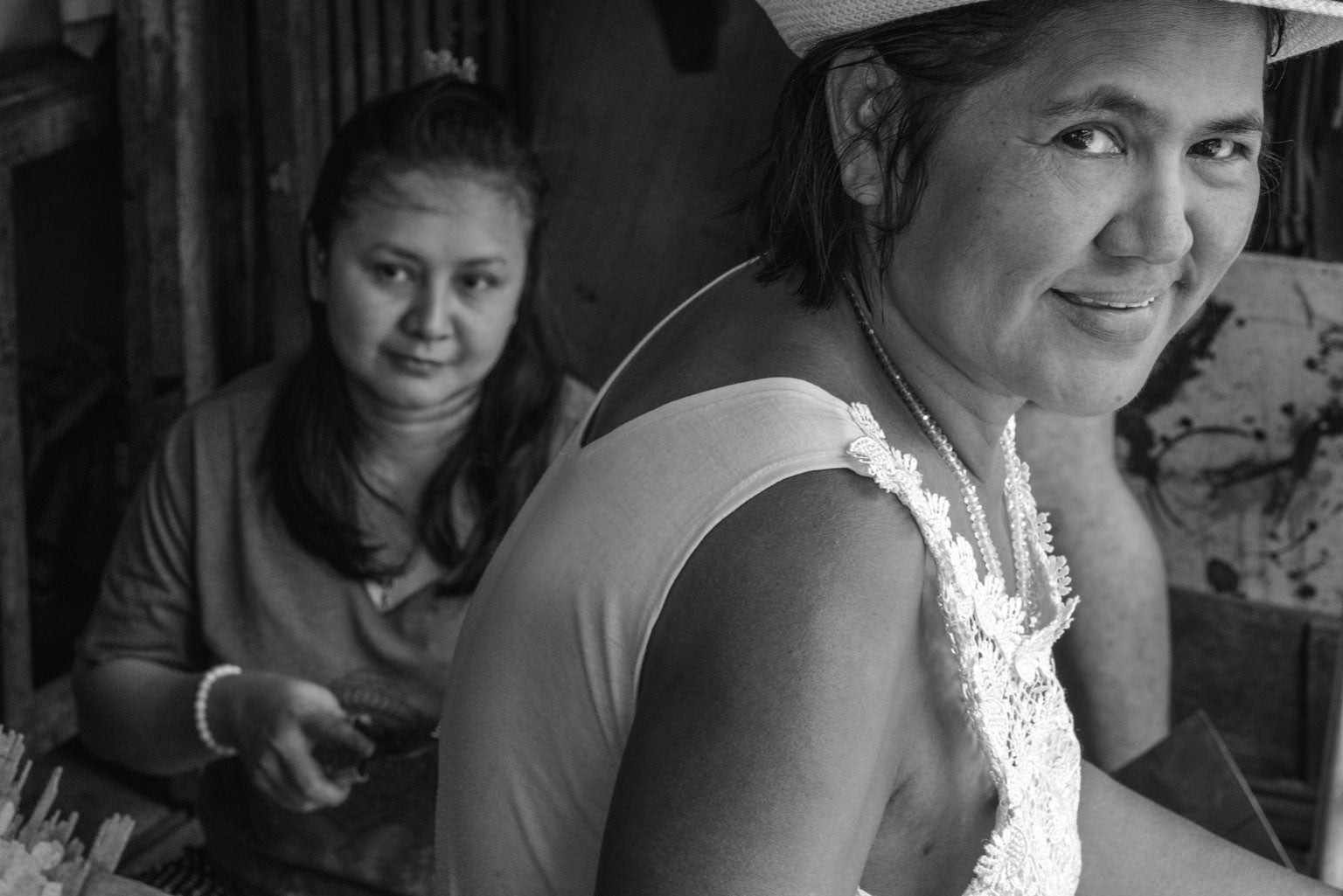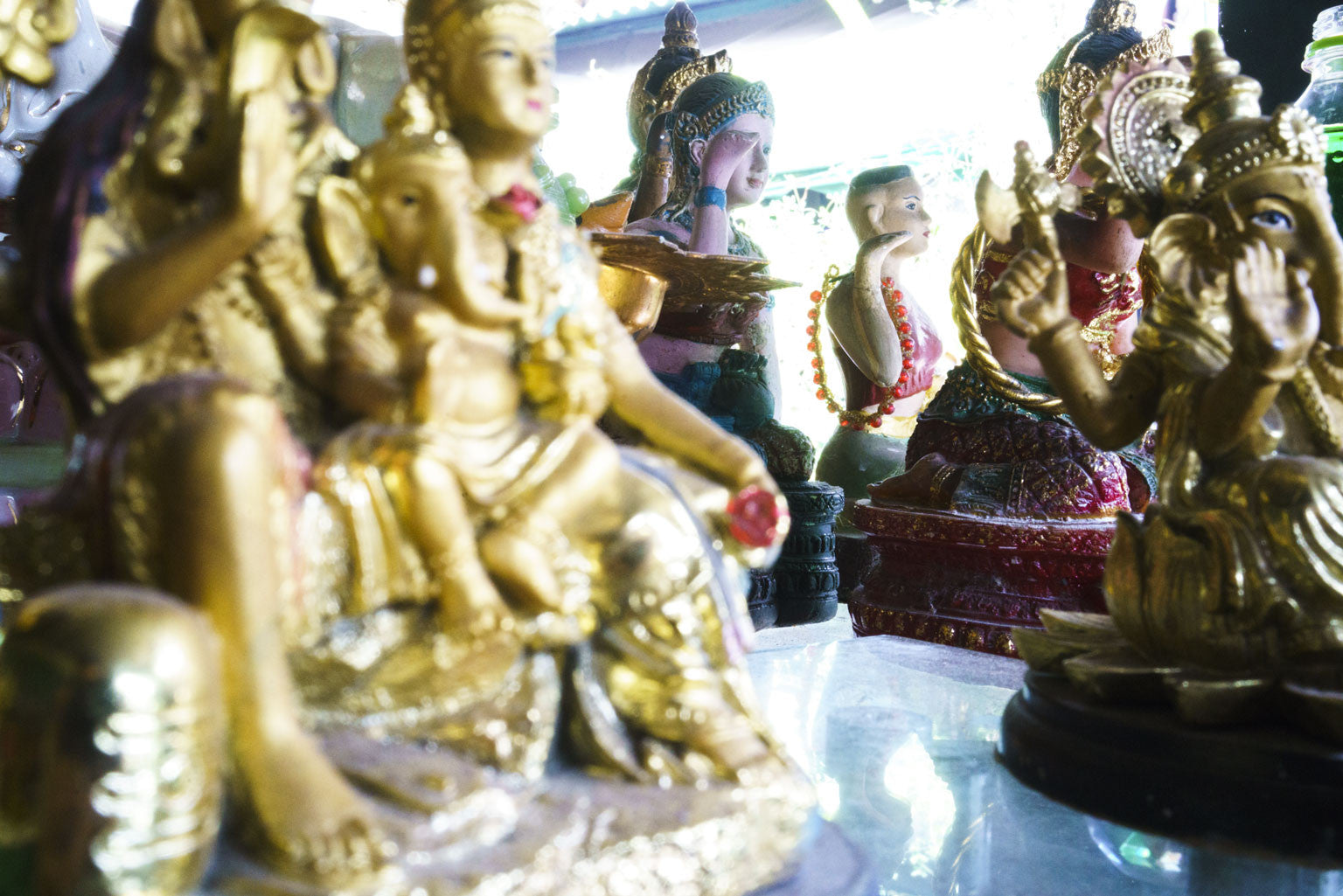THE MASTER OF CRAFT
THE TEMPLE'S TOILERS
BANGKOK, THAILAND
Scroll to explore
The Story
A CONVERSATION WITH Mayuree Suesriserm AND Maneerat Nakrat,
ALMS BOWL MAKERS IN BAN BAT VILLAGE BANGKOK, THAILAND
Mayuree Sueriserm was born into the craft of making alms bowls by hand in the village of Ban Bat, where the tradition has subsisted since a royal decree in the eighteenth century. Pa Gai left school at an early age to work amongst her family, and became one of the few women to master each step of the arduous process of bowl making. Her daughter, Maneerat Nakrat, is working alongside her mother to ensure their craftsmanship continues to be relevant for the benefit of the community artisans and the devout Buddhist monks who use these bowls, as Ban Bat is the last of the villages to preserve this invaluable cultural legacy.

Alms bowls
MAYUREE SUERISERM , ALMS BOWL ARTISAN
are very important,
because they represent the
mind and the soul of a monk.
If a monk does not have an
alms bowl, then he will not
have anything to eat.
S+O — HOW DID YOU BECOME INTERESTED IN THE TRADITION OF ALMS BOWL CRAFTSMANSHIP?
M. Sueriserm — I was born and raised here in Ban Bat. When I was young, all of the adults made a living from crafting alms bowls. I saw these skilled artisans making the bowls, and I wished one day to be as skilled as they were. My grandparents made these bowls. And so did my parents. When I was a bit older, I started to help my parents making the bowls, and eventually learned every single part of the craft. The true alms bowl artisan should be able to complete the whole process, and master every step along the way. My heart loves this work. I have fun while I’m doing it. This is my life’s passion.
M. Nakrat — I had started out working in an office, but soon realized that my mother needed help with the business. I had grown up watching her do this work and learning from her. My father passed away when I was quite young. She had to work hard to raise us. I used to stay up late, when I was old enough, to give her a hand. And now, I am following in her footsteps and taking over the family business. Watching her and then working with her is inspiring. She is my hero.
S+O — WAS IT ALWAYS COMMON FOR WOMEN TO DO THIS WORK?
M. Nakrat — I’m not sure if it was always common. Crafting alms bowls doesn’t necessarily require the strength of a man. Women can do this job as well. Sure it is quite difficult to do the hammering, welding, and to be working with metals. But it is a job that requires refined skills more than sole strength. There are more women working in this business nowadays than the past, which is a good thing.


S+O — TELL US HOW THE TRADITION OF MAKING ALMS BOWLS STARTED IN THE VILLAGE.
M. Sueriserm —Ban Bat was one of several villages founded in the eighteenth century to make alms bowls. In the old days, my grandparents’ generation produced bowls for the palace court, including items for His Majesty when he entered monkhood.
S+O — WHY IS THE ALMS BOWL IMPORTANT TO THE RITE OF MONKHOOD?
M. Sueriserm — Alms bowls are very important, because they represent the mind and the soul of a monk. If he does not have an alms bowl, then he will not have anything to eat.
M. Nakrat —Thai people believe that being ordained as a Buddhist monk is a way to earn merit for your parents. The simple principle is that Thai men, age 20 and above, are expected to become a monk for a period of time, varying from one month to a lifetime, to earn merit for their parents and to further maintain the belief system. When it comes to alms bowls they use, there are two main sects of Buddhism - Dhammayut Nikaya and Maha Nikaya. Maha Nikaya is a relatively less strict sect and, starting in the 1970s, they were allowed, by the King, to use factory-made alms bowls. On the contrary, Dhammayut monks are determined to use handmade alms bowls of the highest quality since they are allowed to only have one alms bowl for life.


S+O — HOW DOES THE BOWL DESIGN SYMBOLIZE BUDDHISM?
M. Nakrat — Buddha’s followers offered alms bowls to Buddha. So Buddha made a wish that the four alms bowls, presented by his followers, would merge into one bowl. The Maha Nikaya bowl is made of four petal-shaped pieces that represent Buddha’s followers, whereas the Dhammayut alms bowl is made of six to eight pieces resembling lotus petals, which also represent the followers of Buddha.
Budda
MANEERAT NAKRAT , ALMS BOWL ARTISAN
made a wish that the
four alms bowls presented by
his followers would merge
together into
one bowl.


S+O — HOW HAS THE DEMAND FOR BOWLS CHANGED OVER TIME?
M. Sueriserm —In the past, everyone in this village made bowls. Everywhere you went, you could see people on the streets making alms bowls. But today, even when I walk around my village, it is hard to find people making these bowls. There are about five households left that still make alms bowls. Ever since the King allowed bowls to be produced in a factory, the tradition has waned. Today, we are the largest bowl-producer in the village employing eight to nine artisans. Our bowls are strictly made to order according to the specifications of the monk or temple.
S+O — WHAT IS THE DIFFERENCE IN QUALITY BETWEEN A FACTORY AND HAND MADE BOWL?
M. Sueriserm — There is a big difference. The bowls produced in the factories are made of round-shaped steel which is made from a mold, and typically last only two to three years. In contrast, we carve every single detail of our bowls by hand. It takes about three days to finish one handmade bowl, and they can last a lifetime.
S+O — WHAT MAKES BAN BAT IMPORTANT TO THE SURVIVAL OF THIS TRADITION?
M. Nakrat — This is the only remaining village in Thailand, which makes handmade alms bowls. So you could also say it is the only place in the world that makes handmade alms bowls. The main reason we continue this tradition is that, if we stopped, the monks would no longer have the ability to use these bowls. Dhammayut monks, who remain monks their whole lives, mainly use this type of alms bowls. Many of these monks have personally asked us to preserve this craftsmanship.
Many
MANEERAT NAKRAT , ALMS BOWL ARTISAN
of these monks
have personally asked us
to preserve this
business.

Credits
Photography by Brian Sokol
Film by Oresti Tsonopoulos
Edited by Daniel Gamino
Special Acknowledgments - Diana Li and Missy Weil of Indagare Travel, Bangon Kachonsittinopkun of Smiling Albino.
The Objects
Exclusive Edition 013 Ban Bat Alms Bowls
The village of Ban Bat is believed to be the last remaining village in Thailand making handmade Alms bowls for Thai Buddhist monks. The village was commissioned the eighteen century by King Rama I to perfect the craft of making these bowls which would be used to by the monks to collect their daily meals. Each bowl is crafted by a series of artisan masters working together to construct the bowls to the highest quality and to last a lifetime.
The Destination
BANGKOK, THAILAND
Bangkok, the seemingly endless metropolis of over eight million inhabitants, is a thoroughly modern city whose charm is best found on foot and by wandering through the narrow residential alleyways of the older districts, including Ban Bat in the old city's temple supply neighborhood. Often behind closed gates or tall walls, the hidden gems that we uncovered would have been nearly impossible to find without our indispensable guide, Kob, who serves as a local expert working closely with our friends at Indagare Travel.



